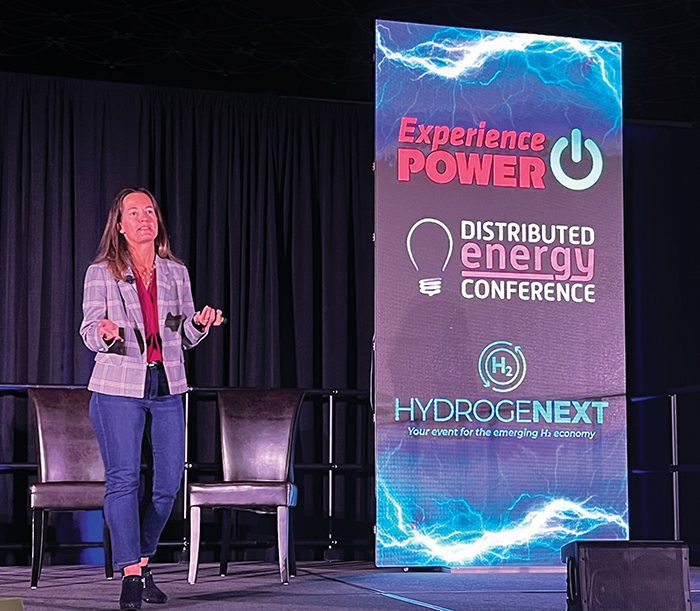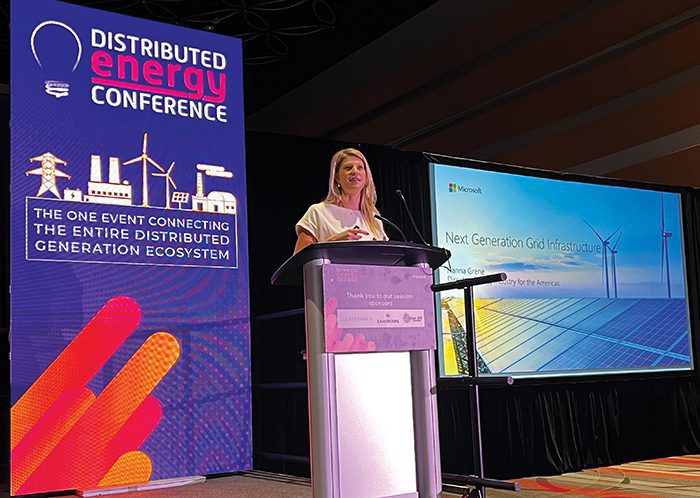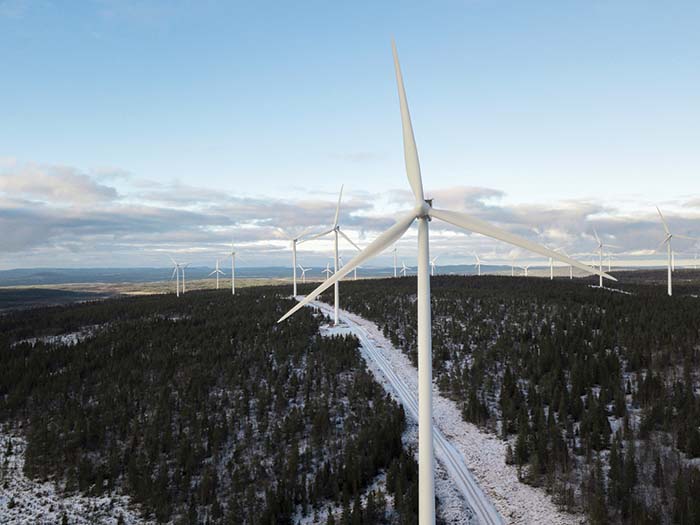Power Event Attendees Welcome the In-Person Experience
 POWER hosted Experience POWER, the Distributed Energy Conference, and HydrogeNext at the Henry B. Gonzalez Convention Center in San Antonio, Texas, October 18-21, 2021. The events were well-received by sponsors and attendees, as industry professionals embraced the opportunity to meet again in person.
POWER hosted Experience POWER, the Distributed Energy Conference, and HydrogeNext at the Henry B. Gonzalez Convention Center in San Antonio, Texas, October 18-21, 2021. The events were well-received by sponsors and attendees, as industry professionals embraced the opportunity to meet again in person.COVID-19 has disrupted all of our lives in countless ways. Many power professionals have grown accustomed to working from home and attending Zoom meetings, but that doesn't mean we all enjoy the seclusion. That's why POWER's events team was so anxious to host Experience POWER, the Distributed Energy Conference, and HydrogeNext in person. It had been far too long since people had gathered together to hear from experts and network with peers.
The response from sponsors and attendees at the events was equally excited. I can't tell you how many people I heard say something like, It's great to be back in person!" While some companies were still limiting travel, which caused attendance to be down somewhat from past years, the feeling I got from everyone who participated was that the events were a resounding success and people can't wait for an even larger get-together next year. Plans are already in place for the three shows to be co-located at the Gaylord Rockies Resort and Convention Center near Denver, Colorado, Oct. 3-6, 2022.
Cutting Carbon a Hot TopicJulia Hamm, president and CEO of the Smart Electric Power Alliance (SEPA), provided a keynote address on Oct. 19 in San Antonio (Figure 1). I can't tell you how excited I am to be here! Pre-pandemic-this was my life. You know, I spent about a third of my time on the road, traveling around the country-around the globe-talking to audiences about utility transformation. But it's actually been 22 months since I stood on a stage until today, and ironically, the last time I was on stage was here in this building," Hamm said.
 |
1. Julia Hamm, president and CEO of the Smart Electric Power Alliance (SEPA) spoke at the co-located Experience POWER, Distributed Energy Conference, and HydrogeNext events. Source: POWER |
Hamm acknowledged that utilities have been evolving and that there have been meaningful reductions in emissions. However, she said the roughly 40% reduction in CO2 emissions from the electric power sector is not good enough. Analysis shows us that as a planet we are on track for a three-degree-Celsius temperature increase by mid-century, if we continue with our current trends and don't change how we operate. That is not acceptable, so we've got to do things differently," she said.
SEPA is not a trade association or lobbying/advocacy group. Hamm said it is simply focused on bringing together all the relevant stakeholders, including the utility industry, regulators, technology companies, large energy users, and big tech companies, to work collaboratively on electric power challenges.
One of the things SEPA has done is to create a Utility Carbon-Reduction Tracker. According to Hamm, the first U.S. utility to commit to a carbon-free goal was Xcel Energy in December 2018. Since then, we've seen utility after utility after utility announce their own ambitious targets to the point now where 72% of customers are served by a utility in the U.S. with a 100% carbon-free goal. Really impressive," she said.
While it's impossible to know how the world's energy sector will become 100% carbon free, most utilities have clear plans on how to reduce carbon emissions by 70%, and some have roadmaps to achieve 80% or even 90% carbon-free power in an affordable way using technology that is commercially available today, Hamm said. Still, more work needs to be done to find solutions for the last mile."
Utilities Leading the WayOne interesting takeaway from Hamm's presentation revolved around SEPA's assessment of where utilities stand in terms of progress toward a cleaner, more modern power grid. The group factored in several variables including how much clean energy the company supplied, how distributed energy resources are handled, how grid modernization is being implemented, how planning and operating practices have evolved within the organization, how the company engaged with other stakeholders, and how corporate leadership managed risks. About 130 utilities participated in the survey and SEPA scored each of them based on their responses.
The results were not published publicly, but Hamm did identify the top 10 in alphabetical order. They were Austin Energy (Texas), Consolidated Edison (New York), Green Mountain Power (Vermont), Holyoke Gas & Electric (Massachusetts), Los Angeles Department of Water & Power (California), Pacific Gas & Electric (California), San Diego Gas & Electric (California), Seattle City Light (Washington), Southern California Edison (California), and Sacramento Municipal Utility District (California). SEPA calls this group its Leaderboard."
So, a couple of interesting facts about these 10: Five of them investor-owned, five of them public power, five of them in California, five of them other places in the country, and my favorite stat, which does not show up in the report but it's my favorite, five have female CEOs, and five have male CEOs. I found that very interesting," said Hamm.
One thing that differentiated the Leaderboard companies from other utilities was their commitment to innovation and collaboration. All of them have formal partnerships with universities; whereas, less than half of non-Leaderboard companies have those types of agreements. Nine out of 10 Leaderboard utilities have technology partnerships with other companies, operate an innovation center," and run a company-owned startup or in-house research and development department. The percentage of non-Leaderboard companies that are engaging in those activities is far less.
There's lots of things utilities are best-in-class at, but there's other things that they're just not. And it's not realistic to think that they will quickly, or at least overnight, become experts in that. So, there's real opportunities to work across the industry-work with partners-to make progress faster," Hamm said.
Microsoft's Larger GoalHanna Grene, director of Energy Industry for the Americas with Microsoft Corp., provided a keynote address on Oct. 20 (Figure 2). Just like Hamm, the last time Grene was on stage at an event was in January 2020 in San Antonio. So, this does feel very much to be the next part of the circle of everything we've been through," she said in her opening.
 |
2. Hanna Grene, director of Energy Industry for the Americas with Microsoft, spoke at the co-located Experience POWER, Distributed Energy Conference, and HydrogeNext events. Source: POWER |
While many utilities and other companies are targeting net-zero carbon emissions by 2050, Microsoft is taking the carbon reduction theme to a whole other level. The company has been carbon-neutral since 2012. That has been achieved primarily through investments in offsets that avoid emissions. The company is currently on a path to reach a 100% supply of clean energy by 2025. However, its most ambitious goal is to be carbon-negative by 2030 and to remove all historical carbon emissions since the company's founding in 1975 by 2050. This is a big goal. It's a goal that looms large and pushes our teams to have conversations around, How do we do more, faster?' because 2030 and 2050 are not that far away," Grene said.
Microsoft has more than 220 data centers worldwide, and the pace of growth in data centers is astounding. The company currently measures data center additions in terms of acres per month," according to Grene. With a footprint that size, it's really a world computer."
That processing and the amount of capabilities that we're able to do with the current Azure footprint is much more around high-volume computing, AI [artificial intelligence] and machine learning capabilities, and even real-time analytics," said Grene. So, it's grown as an asset, it's grown in how it serves industry, and it's certainly grown in the challenge in front of us to accelerate how we're decarbonizing and even using those energy loads as a distributed resource to engage with the grid and help lower those locational marginal emissions."
Microsoft is integrally tied to the power industry. We are indeed now critical infrastructure to critical infrastructure," Grene said. That critical infrastructure that we provide as a hyperscale cloud-computing company and a platform provider, it doesn't happen without the energy behind it and the grid behind it that powers it."
24/7 Clean EnergyIt's one thing to match the total supply of clean energy with the total demand for energy at a data center over the course of a month or year, but it's another thing to use 100% clean energy 24 hours a day, seven days a week. Microsoft is focused on the latter, and partnered with Vattenfall to prove the concept at a pilot project in Sweden (Figure 3).
 |
3. Microsoft partnered with Vattenfall to deliver renewable energy 24/7 to the company's Swedish data centers. This image is of Vattenfall's Stor-Rotliden wind farm, about 20 kilometers north of Fredrika. Courtesy: Vattenfall |
Together, we developed a 24/7 matching capability, aligning their peak renewable production with the peak loads of our data centers, and ensuring that all of our data centers in Sweden were in fact fully covered 24/7 with renewable energy and zero carbon emissions," Grene explained. So, this started as a proof of technology and a pilot at one data center in Sweden, and then rolled out with Vattenfall as a partnership across Sweden, and now Vattenfall is actually rolling it out to other customers that they serve," she said.
Meanwhile, Microsoft is using the experience as a template for similar agreements elsewhere. We are partnering with other renewable energy providers that we work with around the globe to develop similar capabilities, but specified to their market and their assets," said Grene.
-Aaron Larsonis POWER's executive editor.
The post Power Event Attendees Welcome the In-Person Experience appeared first on POWER Magazine.